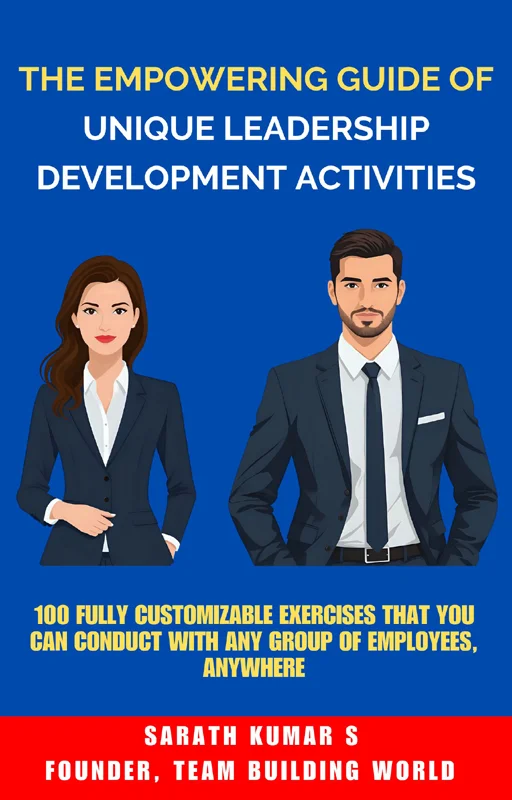10 Team Building Games Without Materials for Adults
Are you in search of some team building games without materials?
Team building is essential for fostering collaboration, trust, and effective communication in the workplace. Sometimes, simplicity is key, and you don’t need elaborate setups or materials to bring a group together.
In this article, let’s see 10 team building activities without materials that are perfect for adults. These games are easy to facilitate, require little to no preparation, and can be played in any setting.
What are Team Building Games Without Materials?
These are activities or challenges that can be played with a group of people without the need for any physical equipment. These games rely on creativity, teamwork, and communication to achieve a common goal.
Some benefits of team building games without materials include:
- Cost-effectiveness: These games require no additional expenses for materials, making them budget-friendly options.
- Convenience: With no need for setup or cleanup, these games can be played anytime and anywhere.
- Inclusivity: Since there are no specific physical requirements, everyone in the team can participate equally.
10 Team Building Games Without Materials for Adults
Here are some engaging team building exercises that you can try in your workplace without any materials.
#1. Two Truths and a Lie
This is a fun icebreaker where participants share interesting facts about themselves. It helps the coworkers get to know each other better.
Time: 10-15 minutes
Materials: None
Participants: 3-8 people in a group
Instructions
- Ask each participant to come up with two true statements and one false statement about themselves.
- Have them share the three statements with their group.
- Encourage the group to discuss and guess which statement is the lie.
- Reveal the correct answer and ask the next group member to continue.
Debrief
Discuss how well the group knows each other and any surprising facts that were revealed. Highlight the importance of active listening and fostering connection within the team.
You can also read: 10 Non-Physical Team Building Activities for Employees
#2. The Human Knot
This game requires physical movement and teamwork to solve a “human knot.” It helps improve communication, trust, and problem-solving skills.
Time: 10-15 minutes
Materials: None
Participants: 5-8 people in a group
Instructions
- Have the participants stand in a circle facing each other.
- Ask everyone to reach out their right hand and grab someone else’s hand across from them.
- Then, have them do the same with their left hand but with a different person. This creates a “human knot.”
- The goal is for the group to untangle themselves without letting go of hands. Encourage communication and problem-solving to find a solution.
Debrief
Discuss how the group communicated, collaborated, and solved the problem. Emphasize the importance of teamwork and effective communication in achieving a common goal.
You can also read: 14 Best Do-it-Yourself (DIY) Team Building Activities
#3. One Word Story
This activity fosters creativity, listening skills, and teamwork as participants create a story together, one word at a time.
Time: 10-15 minutes
Materials: None
Participants: 4-10 individuals per group
Instructions
- Have the group members sit or stand in a circle.
- Start with the first participant saying a single word to begin a story.
- The next participant adds another word, and the story continues around the circle with each person adding one word at a time.
- Try to make it as coherent and humorous as possible.
Debrief
Discuss how well the group listened, collaborated, and built on each other’s ideas. Emphasize the importance of active listening and teamwork in creating something together.
#4. People Scavenger Hunt
This game encourages participants to interact with each other to find common traits or experiences. It helps build connections and understanding within the team.
Time: 10-20 minutes
Materials: None
Participants: 3-10 individuals per group
Instructions
- Create a list of traits or experiences relevant to the group (e.g., “someone who speaks more than one language,” “someone who has travelled to five countries”, etc.).
- Ask everyone to mingle and find someone who fits each description on the list.
- The first person to find someone for each trait/experience wins. Make sure everyone gets a chance to speak and share their answers.
Debrief
Discuss the connections and similarities within the group. Encourage the participants to share interesting facts about themselves and get to know each other better.
#5. 20 Questions
This classic game promotes curiosity, critical thinking, and active listening as participants guess an object, person, or place.
Time: You decide
Materials: None
Participants: 3-8 people in a team
Instructions
- Select one participant to think of an object, person, or place without revealing it to the group.
- The rest of the group takes turns asking yes-or-no questions to figure out what it is.
- The group is limited to asking a total of 20 questions.
- If the group guesses correctly before reaching 20 questions, they win. Otherwise, the participant reveals the answer.
Debrief
Discuss the importance of asking thoughtful questions and listening attentively to narrow down possibilities. Highlight how effective questioning can lead to collaborative problem-solving.
#6. Would You Rather
This exercise encourages participants to share preferences and build connections through fun, hypothetical scenarios.
Time: 10-20 minutes
Materials: None
Participants: 3-8 people in a team
Instructions
- Have one group member start by asking a “Would you rather” question (e.g., “Would you rather travel to space or explore the ocean?”).
- Each group member takes turns answering the question and can elaborate on their choice.
- Continue with others creating and sharing their own “Would you rather” questions.
Debrief
Discuss the diversity of preferences and choices within the team. Use the activity as an opportunity to celebrate individuality and learn about each other’s unique perspectives.
#7. Silent Line-Up
This activity emphasizes non-verbal communication and teamwork as participants work together to achieve a common goal.
Time: 10-15 minutes
Materials: None
Participants: Minimum of 6 people in a group
Instructions
- Ask the group to line up in a specific order (e.g., by height, birth month, or years of experience) without speaking.
- Participants must rely on gestures, expressions, and other non-verbal communication to complete the task.
- Once the group believes they are correctly lined up, they can confirm by speaking.
Debrief
Discuss how the group collaborated without words and the strategies they used to communicate. Highlight the importance of observing and understanding different forms of communication in teamwork.
#8. Story Building
This game promotes active listening, creativity, and teamwork as participants take turns building a story sentence by sentence.
Time: 10-15 minutes
Materials: None
Participants: 3-6 members per team
Instructions
- Start with one participant saying the first sentence of a story (e.g., “Once upon a time…”).
- The next participant adds another sentence to continue the story, and the process continues around the circle.
- Encourage the group to build on each other’s ideas and make it as interesting or humorous as possible.
Debrief
Discuss how well the group listened, collaborated, and built on each other’s ideas. Emphasize the importance of active listening and teamwork in creating something together.
#9. Speed Dating
This game encourages participants to connect and learn about each other in a fun, fast-paced setting.
Time: 10-20 minutes
Materials: None (But use a timer or stopwatch if needed)
Participants: Minimum of 6 people in a group
Instructions
- Divide the group into pairs and have them sit facing each other for one minute.
- Set a timer for one minute and have participants introduce themselves, share their name, and answer a question (e.g., “What’s your favorite hobby?”).
- When the timer goes off, participants rotate to meet someone new until everyone has met each other.
- Repeat with different questions or prompts for multiple rounds.
Debrief
Discuss the connections and interesting facts that were shared during the activity. Use it as an opportunity to highlight the importance of building relationships and finding common ground in teamwork.
#10. Company Trivia
This activity promotes team bonding and knowledge about the company or organization.
Time: You decide
Materials: List of trivia questions related to the company/organization, and small prizes (optional)
Participants: Groups of any size
Instructions
- Create a list of trivia questions related to the company or organization.
- Divide the participants into teams and have them compete against each other to answer the questions.
- Offer small prizes for correct answers or have fun consequences for incorrect answers.
Debrief
Discuss how well the group knows their company/organization and the benefits of being knowledgeable about its history, values, and culture. Use it as an opportunity to celebrate and learn more about the company/organization together.
Want Some Unique Leadership Development Activities?
If you want some unique activities to equip your employees (both in-person and virtual) with leadership skills, qualities, and mindset, you can get my new e-book:
Or Want Some Unique Team Building Activities?
If you want some unique activities for your employees (both in-person and virtual), you can get my new e-book:
Final Words
Experiential learning activities are powerful tools for fostering collaboration, communication, and trust within a group. When implemented effectively, they can break down barriers, encourage creativity, and strengthen relationships. Whether you’re incorporating these games into a workshop, meeting, or casual team gathering, always consider the unique dynamics and preferences of your group. Tailor activities to suit the participants and the intended outcomes, ensuring everyone feels included as well as engaged. With the right approach, these exercises can leave a lasting positive impact on any team.
FAQ: Team Building Games Without Materials
You might have these questions in mind.
What are some good team building games without materials?
Some good team building games without materials include Two Truths and a Lie, Would You Rather, Silent Line-Up, Story Building, Speed Dating, and Company Trivia. These activities focus on communication, collaboration, and creativity and can be conducted with little to no supplies.
Can I use these activities for any group size?
Most of these activities are suitable for groups ranging from 3-10 people. However, some can be adapted for larger groups by dividing them into smaller teams and conducting the activity simultaneously. You can also rotate participants in and out of an activity if it requires a smaller group size.
Can I conduct these activities virtually?
Absolutely! With a little creativity, most of these activities can be modified for virtual meetings or workshops. Use online tools like Zoom or Google Meet to facilitate the activity and ensure everyone can participate and engage.
How often should I incorporate team building activities into my workplace?
It’s up to you as a leader to determine how often team building activities are needed in your workplace. However, it is beneficial to schedule them regularly (e.g., once a week or every few weeks) to maintain strong relationships and promote a positive work culture. Remember that team building is an ongoing process, not just a one-time event. Continuously check in with your team and assess if they would benefit from another activity.
Can these activities also be used for personal development?
Yes! These activities can be adapted for personal development workshops or self-improvement exercises. They can also be used in other group settings, such as with friends or family, to promote teamwork and communication skills. So, you can try them out in different contexts and see how they can benefit you.

